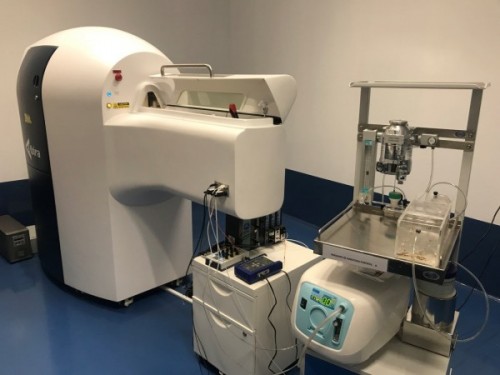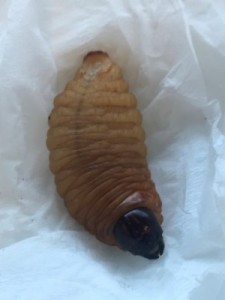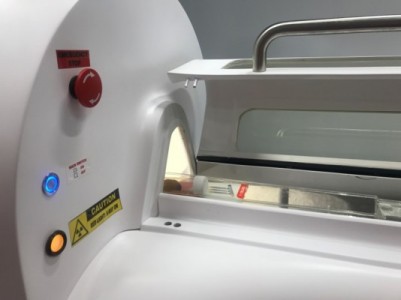Applied Zoology and Biophysics Group
| Responsible | Trinidad León |
RESEARCH SUMMARY
Our group is interested in knowing the effects of climate change on the global biology and physiology of different animal species in a conservation context. In this way, we use both biological and biophysical techniques to understand the different physiological, endocrine, biochemical, morphological and genetic responses. Behaviors and responses are analyzed to quantitatively evaluate the adaptive capacity of each species to the different environmental anomalies linked to climate change. Knowing these answers, we will be able to analyze more in depth the survival capacity of the animal species.
X-Ray Computed Tomography for small animals
RESEARCH LINES
Line 1: Effects of climate change on insect pests. Physiological and genetic responses of the Red Palm Weevil (Rhynchophorus ferrugineus) to thermal anomalies
The red palm weevil (RPW), Rhynchophorus ferrugineus, is considered to be one of the most destructive palm pests in warm areas worldwide. It is native to Southeast Asia and Oceania. However, because of the movement of live infested palms in recent decades, RPW has widely expanded to other regions of Asia, the Mediterranean Basin, the Middle East, Caribbean and California.
Studying the different morphological, physiological and genetic responses we will be able to understand how thermal anomalies affects fitness of RPW, which is relevant for pest management, but also to deepen the knowledge of adaptive capacity of pest insects.
Red Palm Weevil larva inside the X-Ray Computed Tomography System
Line 2: Effects of climate change on non-invasive insects. Quantitative analysis of the different physiological responses to mitigate negative impacts
Climate change can reduce the viability of species leading to a loss of biodiversity. Fitness losses can be mitigated, however, if populations respond adaptively.
Quantifying adaptive responses, or demonstrating their absence, is important in a biodiversity conservation context for predicting species’ abundances. Effects of climate change on biodiversity could thus be mitigated by developing strategies tailored to each species.
Line 3: Cryopreservation of cells, tissues and organs from mammals, birds and insects
Objectives:
. To advance the knowledge about cryopreservation of cells, tissues and organs
. To use part of the cryopreserved biomaterials for relevant research leading to species conservation
. To preserve the genetic/evolutionary information contained in cells for future generations
T. Leon-Quinto, A. Fimia, R. Madrigal , A. Serna
Morphological response of the red palm weevil, Rhynchophorus ferrugineus, to a transient low temperature analyzed by computer tomography and holographic microscopy
Journal of Thermal Biology (2020).
N. Torres-Mantelet, J. Galian, T. Leon-Quinto T, A. Lopez-Lopez
Glacial refuges and cryptic speciation in a Southern Palearctic tiger beetle (Coleoptera: Cicindelidae)
Zoologica Scripta 49, 575-581 (2020)
L. Acosta, T. Leon-Quinto, FJ. Bornay-Llinares, MA. Simon, F. Simon, R. Morchon
Dirofilaria immitis: A New Potential Pathogen for the Endangered Iberian Lynx (Lynx pardinus)
International Journal of Applied Research in Veterinary Medicine 17, 17-21 (2019)
T. Leon-Quinto, JM. Moreno, A. Lopez-Lopez, A. Serna
Effects of vitamin D-induced chronic renal disease on quality and cryopreservation of spermatozoa from the endangered Iberian lynx
Animal Reproduction Science (2018)
JAG. Pertusa, T. Leon-Quinto, G. Berna, JR. Tejedo, A. Hmadcha, FJ. Bedoya, F. Martin, B. Soria
Zn2+ chelation by serum albumin improves hexameric Zn2+-insulin dissociation into monomers after exocytosis
Plos One (2017).
T. Leon-Quinto, MA. Simon, R. Cadenas, A. Martinez, A. Serna
Different cryopreservation requirements in foetal versus adult skin cells from an endangered mammal, the Iberian lynx (Lynx pardinus)
Cryobiology 68, 227-233 (2014)
L. Acosta, T. Leon-Quinto, FJ. Bornay-Llinares, MA. Simon, JG. Esteban
Helminth parasites in faecal samples from the endangered Iberian lynx (Lynx pardinus)
Veterinary Parasitology 179, 175-179 (2011)
T. Leon-Quinto, MA. Simon, A. Sanchez, F. Martin, B. Soria
Cryobanking the genetic diversity in the critically endangered Iberian lynx (Lynx pardinus) from skin biopsies. Investigating the cryopreservation and culture ability of highly valuable explants and cells
Cryobiology 62, 145-151 (2011)
T. Leon-Quinto, MA. Simon, R. Cadenas, J. Jones, FJ. Martinez-Hernandez, FJ. Moreno, A. Vargas, F. Martinez, B. Soria
Developing biological resource banks as a supporting tool for wildlife reproduction and conservation The Iberian lynx bank as a model for other endangered species
Animal Reproduction Science 112, 347-361 (2009)
E. Roche, J. Jones, MI. Arribas, T. Leon-Quinto, B. Soria
Role of small bioorganic molecules in stem cell differentiation to insulin-producing cells
Bioorganic & Medicinal Chemistry 14, 6466-6474 (2006)
Physiological Responses to Extreme Temperatures and Cryopreservation in Different Insect Larvae. Funding agency: PAR-UMH. Duration: 2018-2022.
PI: Trinidad León Quinto
Contract for the Maintenance of the Bank of Biological and Genetic Resources of the Threatened Fauna of Andalusia. Funding agency: Ministry of Agriculture, Fisheries and Environment of the Junta de Andalucía. Duration: 2012.
PI: Trinidad León Quinto
Contract for the realization of the “Bank of Biological and Genetic Resources of the Threatened Fauna of Andalusia”. Funding agency: Ministry of Agriculture, Fisheries and Environment of the Junta de Andalucía. Duration: 2009-2011.
PI: Trinidad León Quinto
Collaboration agreement for the development of the project called: “Bank of Living Cells and Tissues of the Threatened Fauna of Andalusia”. Funding agency: Ministry of Agriculture, Fisheries and Environment of the Junta de Andalucía. Duration: 2005-2008.
PI: Trinidad León Quinto
Obtaining Insulin-Producing Cells from Mouse Embryonic Cells. Functional Characterization. Funding agency: Ministry of Education and Science. Duration: 2004-2005.
PI: Bernat Soria/Trinidad León Quinto
La Vanguardia
Diario Información (1):
https://www.informacion.es/elche/2020/10/28/picudo-rojo-afrontaria-cambio-climatico-21803878.html
Diario Información (2).
El periodic
El Diario.es
Nova Ciencia
https://novaciencia.es/el-picudo-rojo-supera-el-cambio-climatico-mejor-que-el-resto-de-insectos/
Agrodiario
Efe verde
https://www.efeverde.com/noticias/picudo-rojo-mas-resistente-crisis-climatica/






